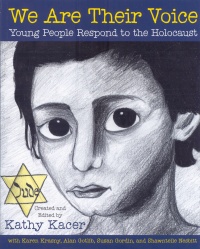| ________________
CM . . .
. Volume XIX Number 12. . . .November 23, 2012.
excerpt:
In We Are Their Voice, Kacer, the author of numerous Holocaust-related titles, including To Hope and Back: The Journey of the St. Louis, introduces 85 writing and drawing selections created by middle school students from Canada, the United States, Australia, and Italy. This project, developed in conjunction with several educators, was prompted by Kacer’s concern that so many Holocaust survivors are now deceased, and these creations are Kacer’s attempt to keep awareness of the Holocaust alive for new generations. Selections are arranged thematically (staying together, hiding, fear, looking for justice, etc.) and introduced by Kacer. The entries range in format from artwork to diary entries to personal interviews to book reviews to letters to short fiction. Some pieces are speculative (based on real events with fictional people) while others are based on specific individuals. The tone throughout is respectful and informative. While few would debate the value of Holocaust education, some will be uncomfortable with this presentation. It is one thing to learn about the Holocaust through the experiences and words of actual survivors—indeed many primary sources have been documented in the years since 1945. Likewise, most readers accept the use of good secondary sources—those compiled by diligent researchers. However, this book asks its student authors to imagine themselves as Holocaust victims and survivors, and despite the authors’ good intentions, a case can be made that this presentation denigrates the experiences of actual Holocaust survivors and victims. One would not ask white students to create fictional pieces putting themselves in the role of Aboriginal residential school attendees because it would be impossible for a white child to fully understand the feelings and experiences that native children endured, and, in some ways, the process of creating these pieces could be construed as disrespectful to the actual experiences. The same standard should hold true for personal experience pieces about other racial/ethnic groups. Certainly Holocaust education is important, but it is perhaps better accomplished through the use of the many excellent primary and secondary sources already available. Recommended with reservations. Kay Weisman, a long-time librarian and reviewer, recently completed her Master of Arts in Children’s Literature from UBC.
To comment
on this title or this review, send mail to cm@umanitoba.ca.
Copyright © the Manitoba Library Association. Reproduction for personal
use is permitted only if this copyright notice is maintained. Any
other reproduction is prohibited without permission.
NEXT REVIEW |
TABLE OF CONTENTS FOR THIS ISSUE
-November 23, 2012.
AUTHORS |
TITLES |
MEDIA REVIEWS |
PROFILES |
BACK ISSUES |
SEARCH |
CMARCHIVE |
HOME |
